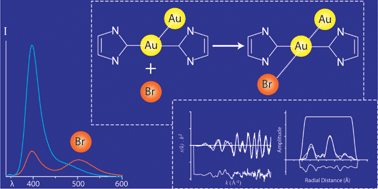Bromide ion binding by a dinuclear gold(i) N-heterocyclic carbene complex: a spectrofluorescence and X-ray absorption spectroscopic study†
Abstract
Fluorescence and

* Corresponding authors
a
Institute for Glycomics, Griffith University, Gold Coast Campus, QLD 4222, Australia
E-mail:
s.berners-price@griffith.edu.au
Tel: +61 7 3735 7290
b School of Chemistry and Biochemistry, University of Western Australia, 35 Stirling Highway, Crawley, WA 6009, Australia
c School of Chemistry, The University of Sydney, NSW, Australia
d Australian Synchrotron, Clayton, Victoria, Australia
e Institute of Materials Structure Science, KEK, Tsukuba, Ibaraki 305-0801, Japan
f
Department of Chemistry, La Trobe Institute of Molecular Science, La Trobe University, Bundoora, VIC 3086, Australia
E-mail:
p.barnard@latrobe.edu.au
Tel: +61 3 94792516
Fluorescence and

 Please wait while we load your content...
Something went wrong. Try again?
Please wait while we load your content...
Something went wrong. Try again?
L. E. Wedlock, J. B. Aitken, S. J. Berners-Price and P. J. Barnard, Dalton Trans., 2013, 42, 1259 DOI: 10.1039/C2DT31817B
To request permission to reproduce material from this article, please go to the Copyright Clearance Center request page.
If you are an author contributing to an RSC publication, you do not need to request permission provided correct acknowledgement is given.
If you are the author of this article, you do not need to request permission to reproduce figures and diagrams provided correct acknowledgement is given. If you want to reproduce the whole article in a third-party publication (excluding your thesis/dissertation for which permission is not required) please go to the Copyright Clearance Center request page.
Read more about how to correctly acknowledge RSC content.
 Fetching data from CrossRef.
Fetching data from CrossRef.
This may take some time to load.
Loading related content
